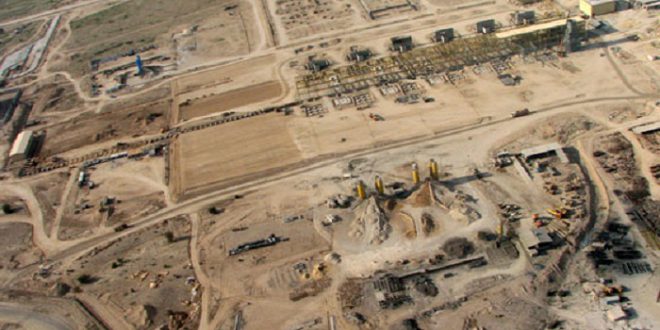West Karoun is now known to Iranians. This border area is expected to form Iran’s oil civilization. According to plans, Iran intends to increase output from the 11 oil fields located in West Karoun by 1 mb/d within four years. The Darquain field will have a 200,000 b/d share in the above figure. Darquain which lies in Khuzestan Province is 45 kilometers north of the city of Khorramshahr and 100 kilometers south of the oil-rich city of Ahvaz. The field is expected to see its output exceed 220,000 b/d once phase 3 development is fulfilled.
Darquain is one of the 49 oil fields introduced for investment under the Iran Petroleum Contract (IPC) model.
Darquain which was discovered in 1964 following drilling one exploration well, holds over 5 billion barrels of oil in place, 1.3 billion barrels of which is recoverable. Darquain’s oil is light with an API gravity of 39. The oil produced at this field is delivered to the Ahvaz-Abadan oil pipeline.
According to estimates, the investment required for the development of Darquain-3 amounts to $1.5 billion. Darquain-3 envisages operating the Ilam and Sarvak reservoirs, as well as the untaped part of Fahlyan. To that end, water and gas would be injected into the Sarvak reservoir and gas into the Fahlyan reservoir.
Furthermore, 31 oil well, 6 gas injection wells, crude oil processing facilities including line pipes, processing installations, gas compressors, infrastructure including crude oil storage tanks and roads are among other activities under way at Darquain-3.
Darquain-1 and Darquain-2 were developed by Italy’s Eni under buyback deals. A state-of-the-art technology – simultaneous oil and associated gas injection – is being used there.
In August 2011, an agreement was signed with an Iranian consortium for the Darquain-3 development after Eni quit cooperating with Iran due to international sanctions. But the Iranian consortium failed to handle the project and the project remains open to international investment.
In phases 1 and 2, oil was recovered from Fahlyan formation. In phase 3, oil recovery from the Ilam and Sarvak layers will be done as well.
Darquain-1 came online in 2005. Darquain-2 required $1.3 billion in investment and demining 7.5 million square meters. Darquain-2 came online in February 2011.
Darquain-3 was expected to become operational within five years. Three years have since passed and the field is still far from startup. According to plans, in the first stage, 14,000 b/d of light crude and in the second stage, 46,000 b/d of heavy crude will be extracted from the Ilam and Sarvak layers.
Darquain-3 targets the heavy crude layers of Ilam and Sarvak and the undeveloped part of Fahlyan. Eni completed feasibility studies on this project and submitted its results.
The findings of Eni studies indicate that the heavy crude in the Ilam and Sarvak layers were recoverable. Due to the heavy crude oil content, the third phase is totally different from the first and second phases.
Therefore, with a view to developing Darquain-3, National Iranian Oil Company (NIOC) held talks with foreign companies for partnership after Iran’s nuclear deal with six world powers came into effect in 2016.
Jahangir Pourhang, CEO of Arvandan Oil and Gas Production Company (AOGPC), announced in February that Darquain’s output capacity had increased 20,000 b/d over the past year. He had said that a tender bid was held for workover on five wells in this oil field.
$135bn Investment Needed
Development of joint oil and gas fields in Iran has slowed down in recent years due to financial and technical shortages. That had earned Iran’s neighbors big margins. Due to the financial and technical restrictions, Iran has concentrated on the development of the South Pars gas field, shared with Qatar, and West Karoun oil fields, shared mainly with Iraq.
Iran has introduced the fields jointly owned with Iraq to foreign companies for development so that they would agree with Iran under IPC terms. One of these fields is Arvand.
The Arvand oil field in Khuzestan Province is located 50 kilometers south of Abadan and at the estuary of Arvandroud River.
This field measures 42 meters in length and 13 meters in width with about 1 billion barrels of oil in place. The recovery rate for this field is estimated at 15%. The Arvand field also contains over 14 bcm of dry gas and 55 million barrels of gas condensate.
The Arvand field was discovered in August 2008. The oil reservoir of this field lies along the Iran-Iraq border. The Fahlyan reservoir of this jointly-owned field holds light crude oil with an API gravity of 44.
Several years ago, an agreement was signed between AOGPC and Iranian Offshore Engineering and Construction Company (IOEC) for the development of the Arvand oil field. The agreement never came into effect due to financial problems.
According to the predetermined schedule, the Arvand field is expected to start producing oil at 5,000 b/d which would reach 20,000 b/d in the final phase. The total investment envisaged for this field is $135 million, which is likely to be revised up. According to plans, Arvand’s oil will be delivered to Abadan refinery.
Iran and Iraq currently share Dehloran, Naftshahr, West Paydar, Azar, Azadegan, Yadavaran, Aban and Arvand. However, in neighboring Iraq, they are known under different names.
Due to unequal recovery from this field and the possibility of migration, NIOC is currently concentrating on the development of joint oil fields.
 Iran Energy News Oil, Gas, Petrochemical and Energy Field Specialized Channel
Iran Energy News Oil, Gas, Petrochemical and Energy Field Specialized Channel




